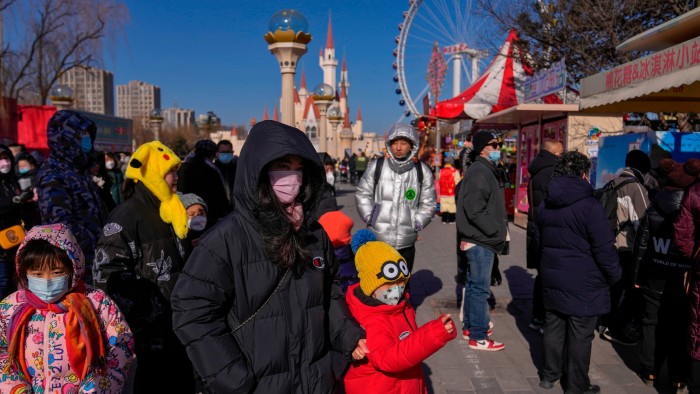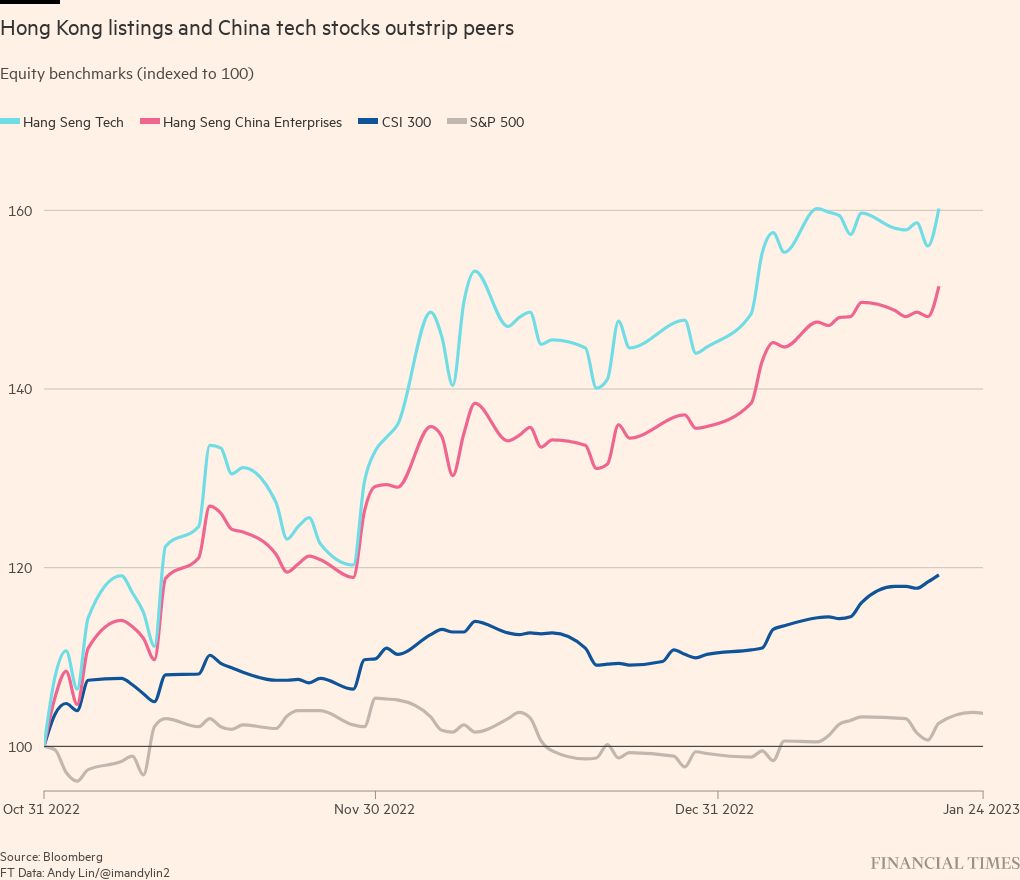What China’s reopening means for markets

Simply sign up to the Chinese business & finance myFT Digest -- delivered directly to your inbox.
China’s reopening to the world after three years of President Xi Jinping’s zero-Covid policy has arrived, spurring hopes of a broad economic revival.
Traders are already betting on surges in demand for copper, iron ore and Chinese tech stocks, which have staged a $700bn rally since their low in October 2021. On Monday, gains for China’s benchmark CSI 300 index pushed it more than 20 per cent above its most recent trough, meeting the technical definition of a bull market.
But the recovery of the world’s second-largest economy is far from certain. With slower global economic growth in the US and Europe, exports are expected to be subdued after a pandemic boom.
“Markets have high expectations for China’s [economic] data to show real improvement in February, but that’s still far from certain,” said Ken Cheung, chief foreign exchange strategist for Asia at Mizuho Bank.
A property sector liquidity crunch and years of sporadic lockdowns have taken a toll on Chinese consumers, and many small and medium-sized employers have gone under.
“Remember, China adopted zero-Covid for three years, and consumption patterns may have changed quite a lot in that time,” Cheung added.
Here are some of the asset classes and sectors that traders and strategists are watching as China fully exits self-imposed quarantine.
Demand soars for hard commodities
China is still one of the biggest consumers of hard commodities, which have been some of the largest winners to date from its reopening thanks to expectations that Beijing’s renewed support for the property market will jump-start demand.
He Tianyu, an analyst at commodity consultancy CRU, said “the real estate recovery, the push to deliver unfinished homes, renewable energy and new energy vehicles are still the main drives for copper”.
Citi analyst Shreyas Madabushi pointed to a “raft of bullish developments, including an accelerated reopening, anticipated restocking by Chinese steel mills amid low inventories, and demand and supply-side support measures for China’s property sector”. Citi forecasts iron ore prices to hit $130 a tonne on stronger demand spurred by accelerated reopening.
Oil price ‘wild card’
Brent crude, the international benchmark, has fallen since Beijing began loosening Covid-19 restrictions, in part because of fears that Chinese demand would only pick up gradually.
But the International Energy Agency has forecast global oil demand to rise to an all-time high of 101.7mn barrels a day this year on the back of China’s reopening — one of two “wild cards” it flagged for the coming year, alongside Russia.
Chinese oil demand, which had fallen in 2022 for the first time since 1990, rose in November by 470,000 b/d compared with October, according to IEA data.
Jeff Currie, head of commodities research at Goldman Sachs, estimated in a recent note that China demand could add $5 to the price of oil, “with international travel potentially an additional tailwind”.
Asian currencies benefit
China’s own currency has rallied since the reopening began, but senior officials in Beijing have warned against “one-way bets” on the renminbi’s appreciation, language typically used in an attempt to deter speculation.
Cheung, at Mizuho, warns that “we’re still prepared for more two-way volatility in the renminbi market” and has forecast the currency to end the year at Rmb6.7 against the dollar.
Thailand’s currency is widely favoured to rally further as Chinese tourists once again travel abroad, with forwards markets predicting the baht will end the year 4 per cent higher against the dollar, while the Australian dollar is expected to climb 3 per cent on increased demand from China for commodities.
The South Korean won has posted even bigger gains and is up more than 15 per cent against the greenback over that same period. But Cheung warned that a dim outlook for South Korea’s economy and geopolitical tensions would be likely to cap further gains this year in spite of a widely anticipated surge in exports to China.
China-linked equities rally
Goldman Sachs analysts recently raised their forecast for earnings growth of Chinese equities to 17 per cent in 2023, up from 13 per cent previously, and boosted the outlook for Chinese listings in Hong Kong to 34 per cent, up from 28 per cent. Markets in Malaysia, Thailand and Singapore are also tipped to benefit as stocks with greater exposure to China’s economy get a shot in the arm.
As a years-long crackdown on technology stocks eases up, investors are also favouring Chinese tech stocks. Analysts at Morgan Stanley recommend “large-cap, highly liquid Chinese internet companies, with a preference for Alibaba”.
Resurgence of interest in developer debt
China’s renewed support for the property sector has given a boost to bonds issued by developers. Dollar bonds from real estate groups such as Country Garden and Dalian Wanda have clawed their way back to face value after trading in distressed territory. This month, Wanda priced its first dollar bond in more than a year, helping it to refinance some of its existing debt.
“The momentum is back,” said one Hong Kong-based bond trader with a Chinese state-run bank. Beijing’s supportive policy is encouraging private banks and hedge funds to put their money back into developer bonds, he said.
Demand for pork tumbles
One big exception to the reopening rally rule is pork, the spot price of which has fallen by almost 50 per cent since Beijing began relaxing Covid restrictions.
China is the world’s largest producer and consumer of pork, but many homes have switched to cheaper chicken during the pandemic. That has left pig futures traded on the Dalian Commodity Exchange down about a quarter since China began easing restrictions.
The result, said Darin Friedrichs, a commodity analyst at Shanghai-based Sitonia Consulting, is that China’s contribution to demand for global protein will be “weaker than it might’ve otherwise been”.




Comments